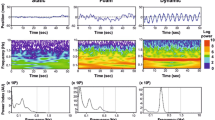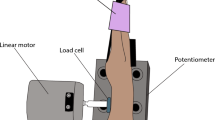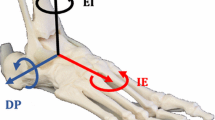Abstract
We first explored whether the ability of subjects to detect the direction of slow ramp imposed movements may be improved by the application of mechanical noise to muscle tendons. Movements were plantar/dorsal flexion of the ankle at 0.04°/s, and the amplitude was just sub-threshold for each subject. A white noise signal (random vibration), low-pass filtered to 100 Hz and distributed uniformly in amplitude, was applied to both the extensor and the flexor ankle muscle tendons with four different mean amplitudes (20, 30, 100, 280 μm). The population of subjects was observed to exhibit clear stochastic-type behaviour: their ability to determine the direction of sub-threshold movements significantly increased when the two lower levels of noise were added and subsequently decreased when the noise magnitude was enhanced. Second, using microneurography, we explored the response of 9 primary muscle spindle afferents and 8 cutaneous afferents to the same imposed movements with and without noise application. While these conditions of ankle mobilisation were too small to induce a response in most of the recorded afferents, two muscle afferents exhibited responses that were characteristic of aperiodic stochastic resonance behaviour: the unit movement response was either triggered or improved by the application of an optimal level of noise. All cutaneous afferents were unresponsive to the imposed movements with or without noise application. We conclude that ankle movement sense can be significantly improved by adding an optimal level of mechanical noise to ankle muscle tendons and discuss the optimisation of the response of movement-encoding receptors that may account for this improvement. The application of a mechanical noise on ankle muscle tendons may constitute a means of improving postural stability in subjects with sensory deficits.




Similar content being viewed by others
References
Aimonetti JM, Hospod V, Roll JP, Ribot-Ciscar E (2007) Cutaneous afferents provide a neuronal population vector that encodes the orientation of human ankle movements. J Physiol 580:649–658
Aimonetti JM, Roll JP, Hospod V, Ribot-Ciscar E (2012) Ankle joint movements are encoded by both cutaneous and muscle afferents in humans. Exp Brain Res 221:167–176
Anderson JS, Lampl I, Gillespie DC, Ferster D (2000) The contribution of noise to contrast invariance of orientation tuning in cat visual cortex. Science 290:1968–1972
Bergenheim M, Johansson H, Pedersen J (1995) The role of the gamma-system for improving information transmission in populations of Ia afferents. Neurosci Res 23:207–215
Blanchard C, Roll R, Roll JP, Kavounoudias A (2011) Combined contribution of tactile and proprioceptive feedback to hand movement perception. Brain Res 1382:219–229
Chow CC, Imhoff TT, Collins JJ (1998) Enhancing aperiodic stochastic resonance through noise modulation. Chaos 8:616–620
Collins JJ, Chow CC, Capela AC, Imhoff TT (1996a) Aperiodic stochastic resonance. Physical Review E 54:5575–5584
Collins JJ, Imhoff TT, Grigg P (1996b) Noise-enhanced information transmission in rat SA1 cutaneous mechanoreceptors via aperiodic stochastic resonance. J Neurophysiol 76:642–645
Collins JJ, Imhoff TT, Grigg P (1996c) Noise-enhanced tactile sensation. Nature 383:770
Collins JJ, Imhoff TT, Grigg P (1997) Noise-mediated enhancements and decrements in human tactile sensation. Phys Rev E 56:923–926
Collins DF, Refshauge KM, Todd G, Gandevia SC (2005) Cutaneous receptors contribute to kinesthesia at the index finger, elbow, and knee. J Neurophysiol 94:1699–1706
Cordo P, Inglis JT, Verschueren S, Collins JJ, Merfeld DM, Rosenblum S, Buckley S, Moss F (1996) Noise in human muscle spindles. Nature 383:769–770
Dhruv NT, Niemi JB, Harry JD, Lipsitz LA, Collins JJ (2002) Enhancing tactile sensation in older adults with electrical noise stimulation. NeuroReport 13:597–600
Edin BB, Johansson N (1995) Skin strain patterns provide kinaesthetic information to the human central nervous system. J Physiol 487(Pt 1):243–251
Edin BB, Vallbo AB (1990) Classification of human muscle stretch receptor afferents: a Bayesian approach. J Neurophysiol 63:1314–1322
Fallon JB, Carr RW, Morgan DL (2004) Stochastic resonance in muscle receptors. J Neurophysiol 91:2429–2436
Gilhodes JC, Roll JP, Tardy-Gervet MF (1986) Perceptual and motor effects of agonist-antagonist muscle vibration in man. Exp Brain Res 61:395–402
Gravelle DC, Laughton CA, Dhruv NT, Katdare KD, Niemi JB, Lipsitz LA, Collins JJ (2002) Noise-enhanced balance control in older adults. NeuroReport 13:1853–1856
Hospod V, Aimonetti JM, Roll JP, Ribot-Ciscar E (2007) Changes in human muscle spindle sensitivity during a proprioceptive attention task. J Neurosci 27:5172–5178
Inbar G, Madrid J, Rudomin P (1979) The influence of the gamma system on cross-correlated activity of Ia muscle spindles and its relation to information transmission. Neurosci Lett 13:73–78
Ivey C, Apkarian AV, Chialvo DR (1998) Noise-induced tuning curve changes in mechanoreceptors. J Neurophysiol 79:1879–1890
Liu W, Lipsitz LA, Montero-Odasso M, Bean J, Kerrigan DC, Collins JJ (2002) Noise-enhanced vibrotactile sensitivity in older adults, patients with stroke, and patients with diabetic neuropathy. Arch Phys Med Rehabil 83:171–176
McDonnell MD, Ward LM (2011) The benefits of noise in neural systems: bridging theory and experiment. Nat Rev Neurosci 12:415–426
Mendez-Balbuena I, Manjarrez E, Schulte-Monting J, Huethe F, Tapia JA, Hepp-Reymond MC, Kristeva R (2012) Improved sensorimotor performance via stochastic resonance. J Neurosci 32:12612–12618
Moss F, Ward LM, Sannita WG (2004) Stochastic resonance and sensory information processing: a tutorial and review of application. Clin Neurophysiol 115:267–281
Priplata AA, Niemi JB, Harry JD, Lipsitz LA, Collins JJ (2003) Vibrating insoles and balance control in elderly people. Lancet 362:1123–1124
Priplata AA, Patritti BL, Niemi JB, Hughes R, Gravelle DC, Lipsitz LA, Veves A, Stein J, Bonato P, Collins JJ (2006) Noise-enhanced balance control in patients with diabetes and patients with stroke. Ann Neurol 59:4–12
Proske U, Gandevia SC (2009) The kinaesthetic senses. J Physiol 587:4139–4146
Refshauge KM, Fitzpatrick RC (1995) Perception of movement at the human ankle: effects of leg position. J Physiol 488(Pt 1):243–248
Roll JP, Vedel JP (1982) Kinaesthetic role of muscle afferents in man, studied by tendon vibration and microneurography. Exp Brain Res 47:177–190
Roll JP, Vedel JP, Ribot E (1989) Alteration of proprioceptive messages induced by tendon vibration in man: a microneurographic study. Exp Brain Res 76:213–222
Ross SE (2007) Noise-enhanced postural stability in subjects with functional ankle instability. Br J Sports Med 41:656–659
Tock Y, Inbar GF, Steinberg Y, Ljubisavljevic M, Thunberg J, Windhorst U, Johansson H (2005) Estimation of muscle spindle information rate by pattern matching and the effect of gamma system activity on parallel spindles. Biol Cybern 92:316–332
Vallbo AB, Johansson RS (1984) Properties of cutaneous mechanoreceptors in the human hand related to touch sensation. Hum Neurobiol 3:3–14
Vedel JP, Roll JP (1982) Response to pressure and vibration of slowly adapting cutaneous mechanoreceptors in the human foot. Neurosci Lett 34:289–294
Volgushev M, Eysel UT (2000) Neuroscience. Noise makes sense in neuronal computing. Science 290:1908–1909
Acknowledgments
The authors thank Guy Escoffier for technical support, the American Journal Experts and, particularly, Dr. Michele Avissar-Whiting for correcting the English writing, and the CNRS and INSERM for supporting this study.
Conflict of interest
The authors have no conflict of interest to disclose.
Author information
Authors and Affiliations
Corresponding author
Rights and permissions
About this article
Cite this article
Ribot-Ciscar, E., Hospod, V. & Aimonetti, JM. Noise-enhanced kinaesthesia: a psychophysical and microneurographic study. Exp Brain Res 228, 503–511 (2013). https://doi.org/10.1007/s00221-013-3581-6
Received:
Accepted:
Published:
Issue Date:
DOI: https://doi.org/10.1007/s00221-013-3581-6




